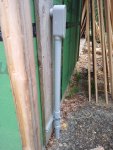Logisticsman
Member
- Location
- Michigan
- Occupation
- Logistics
Hello,
I am running 1" PVC from residence to a detached garage. Distance is about 45' and the PVC will be buried the required 18" depth and will have a 90 degree transition to the garage at about the halfway point of the run. A NEMA 4X J-box will be mounted on exterior of residence and will be about 2' from the ground. Is it necessary/recommended to use an expansion joint when connecting the PVC to the J-box? Thank you.
I am running 1" PVC from residence to a detached garage. Distance is about 45' and the PVC will be buried the required 18" depth and will have a 90 degree transition to the garage at about the halfway point of the run. A NEMA 4X J-box will be mounted on exterior of residence and will be about 2' from the ground. Is it necessary/recommended to use an expansion joint when connecting the PVC to the J-box? Thank you.


